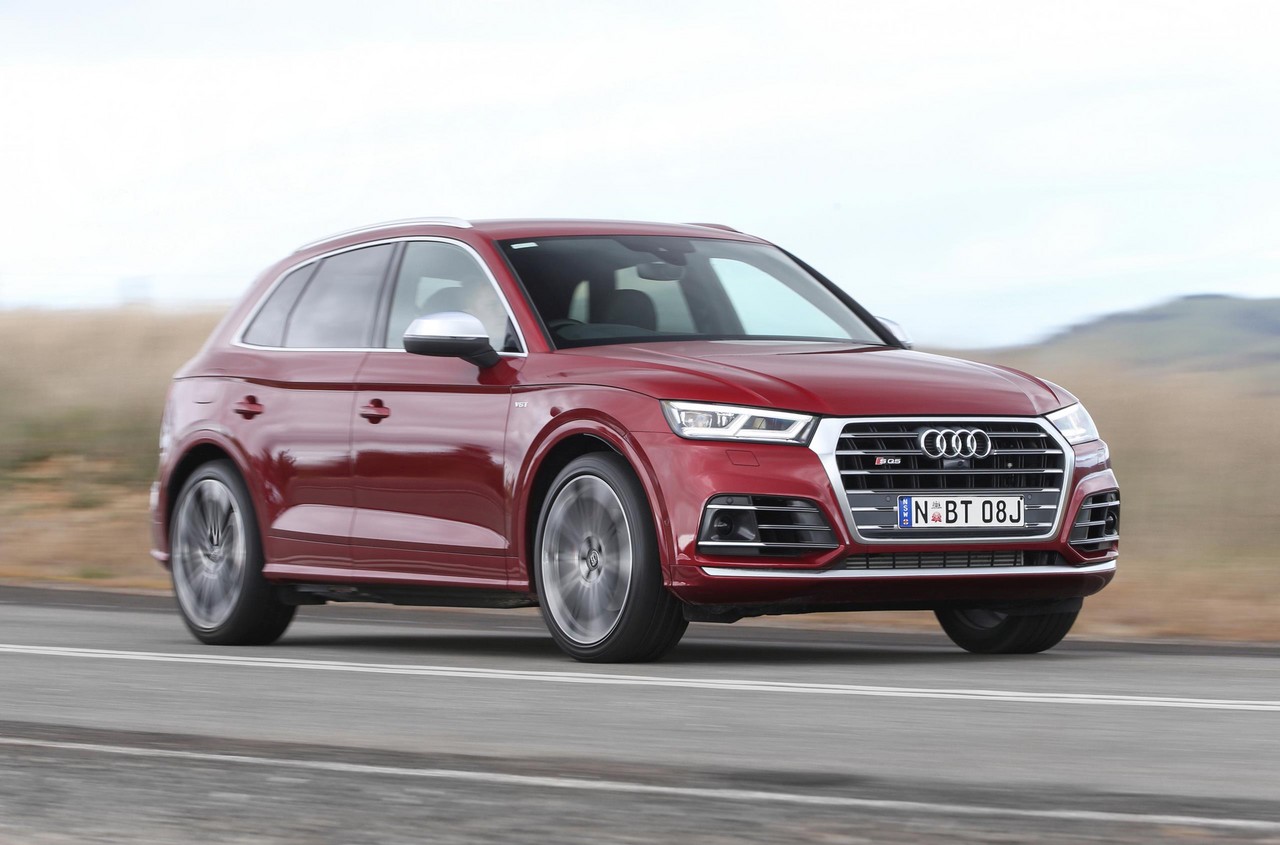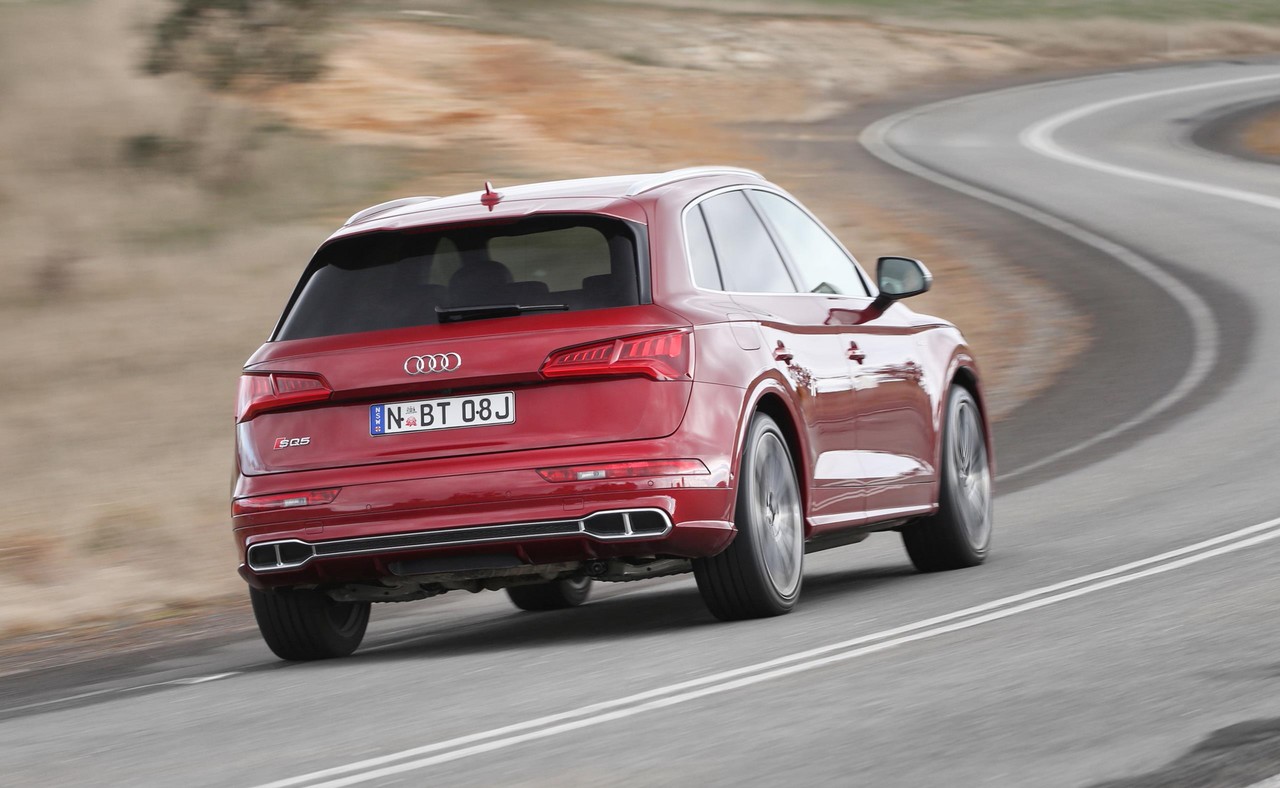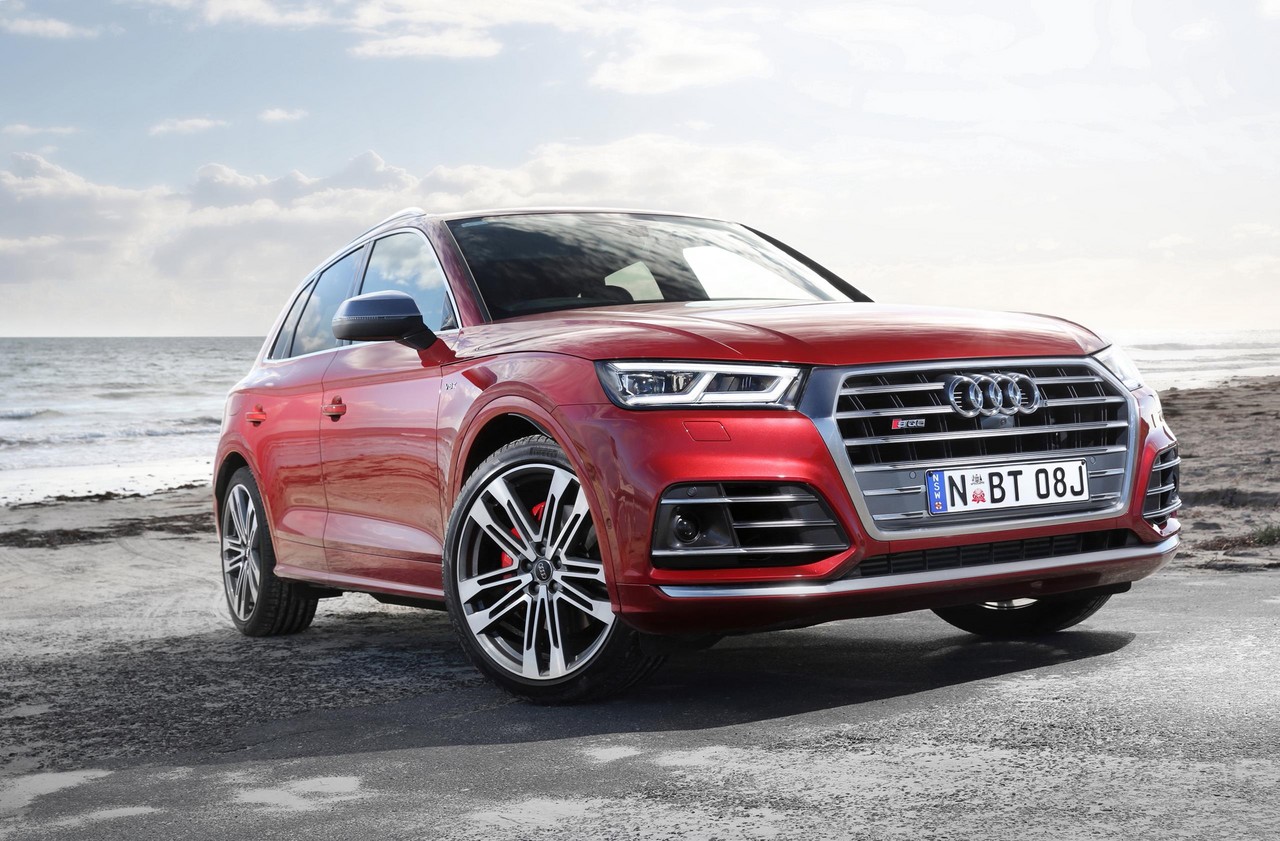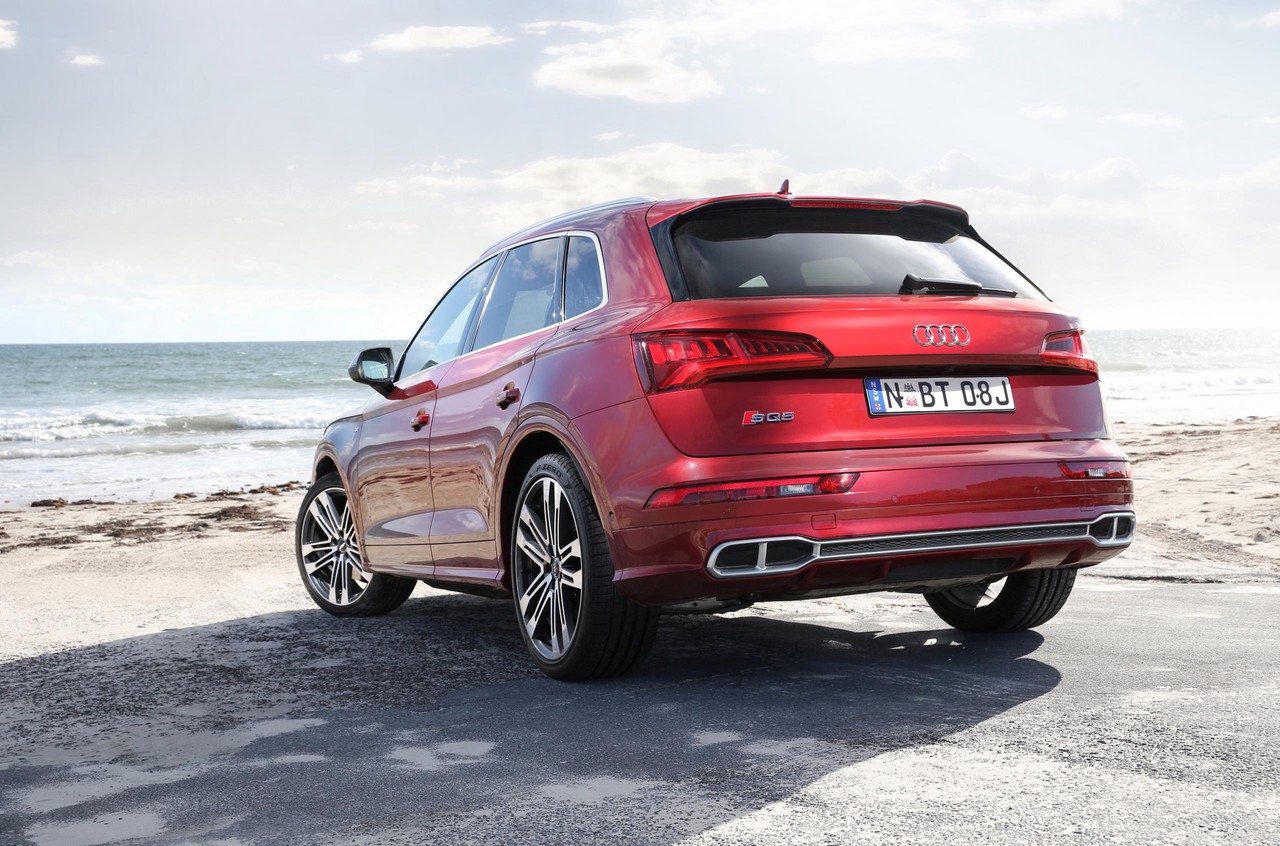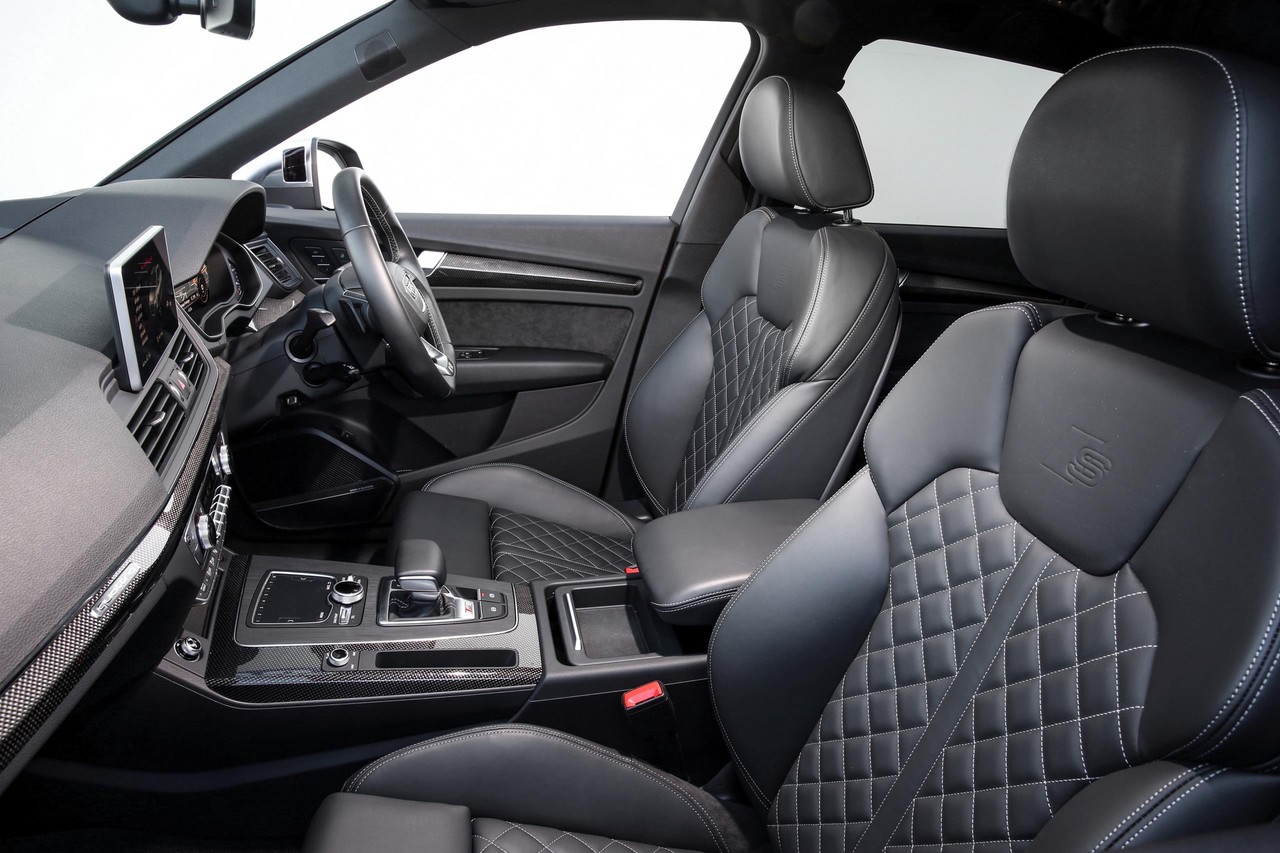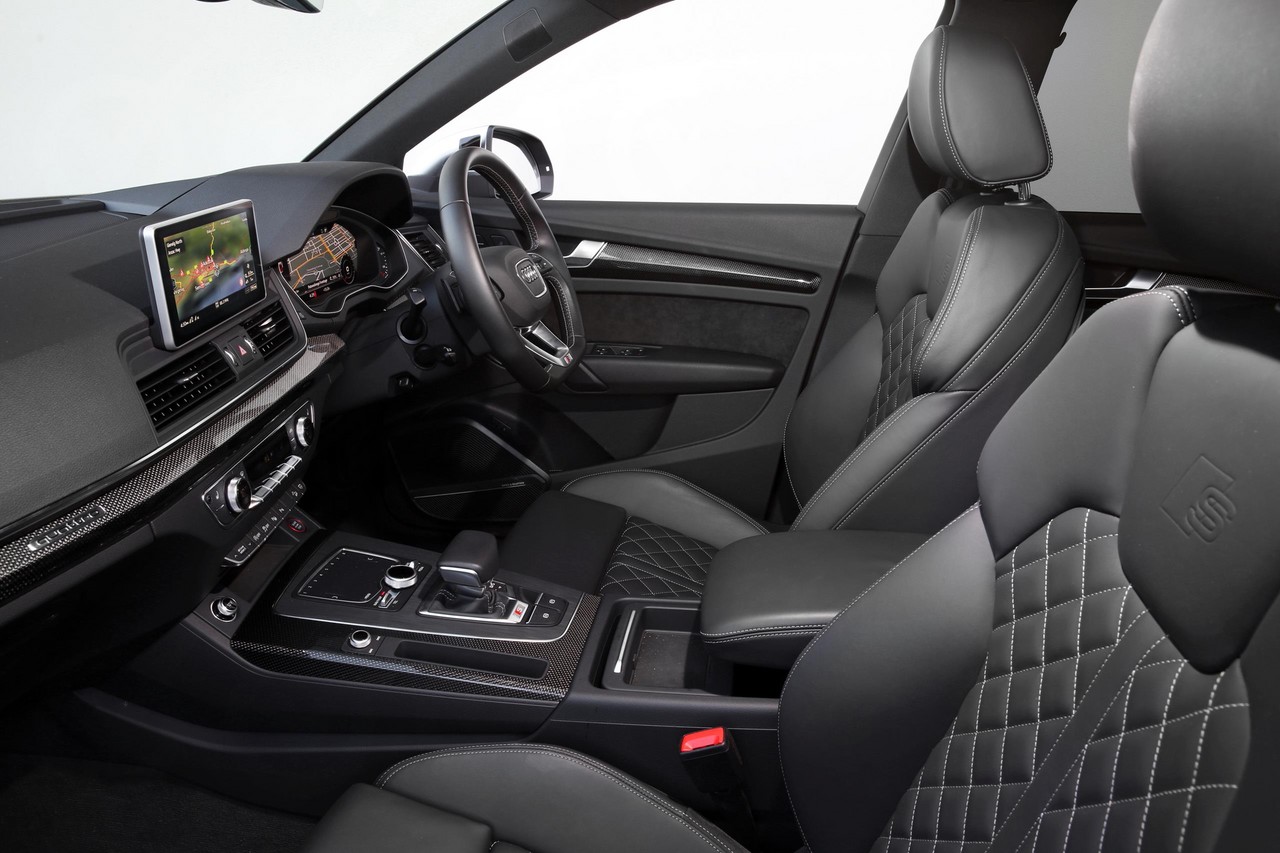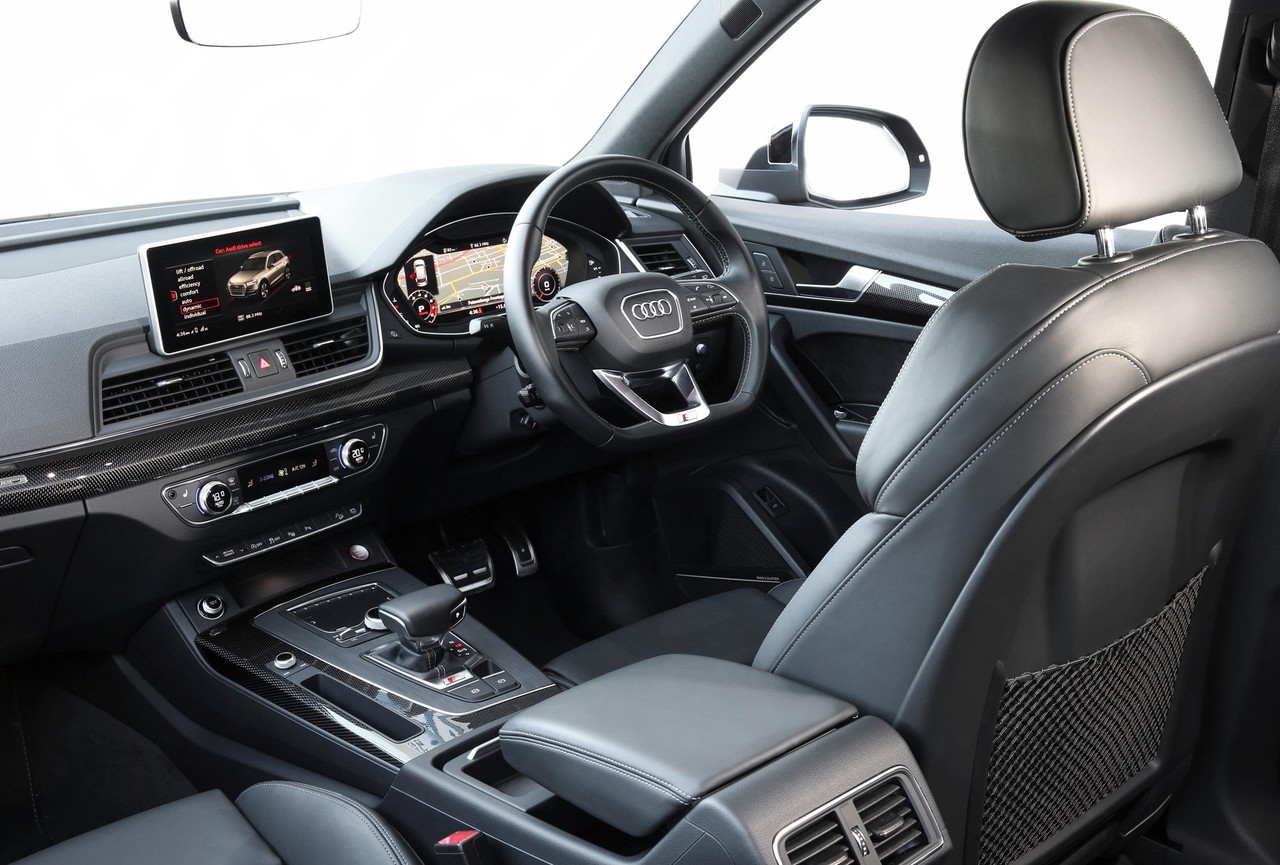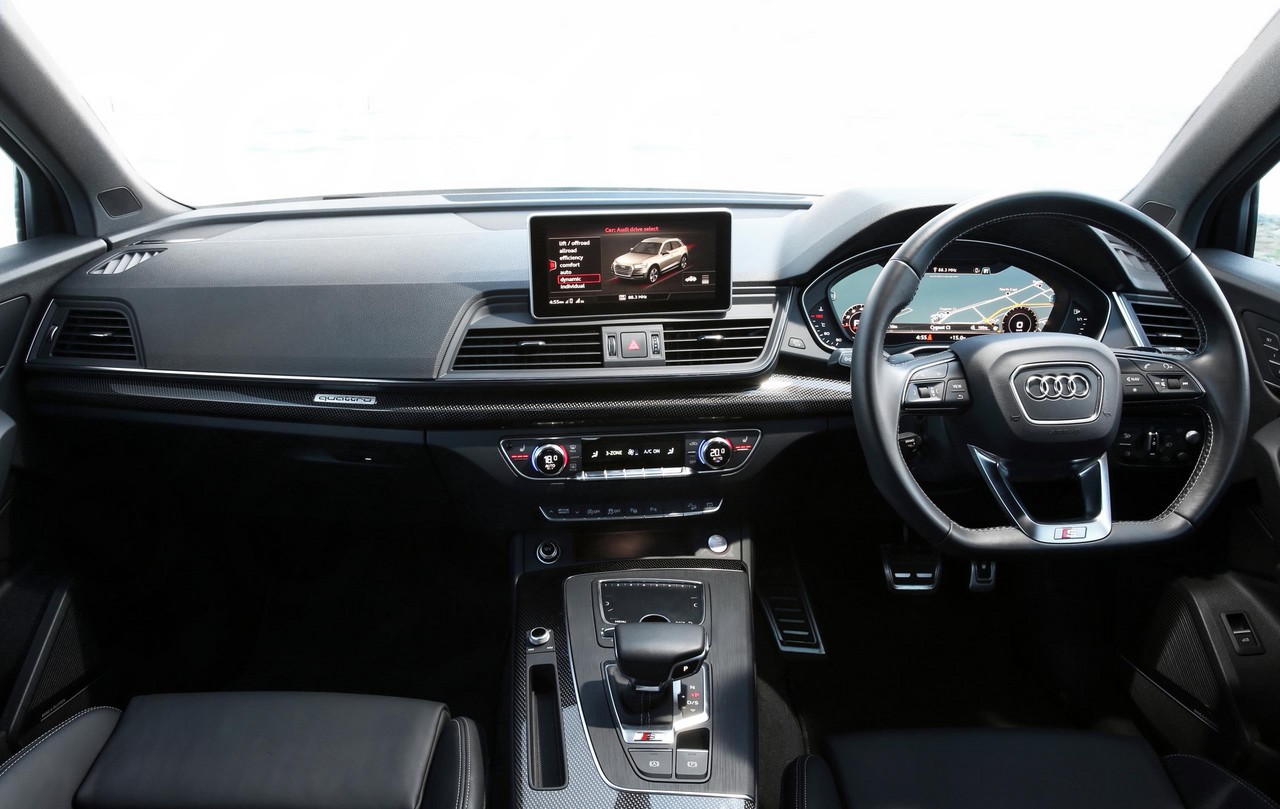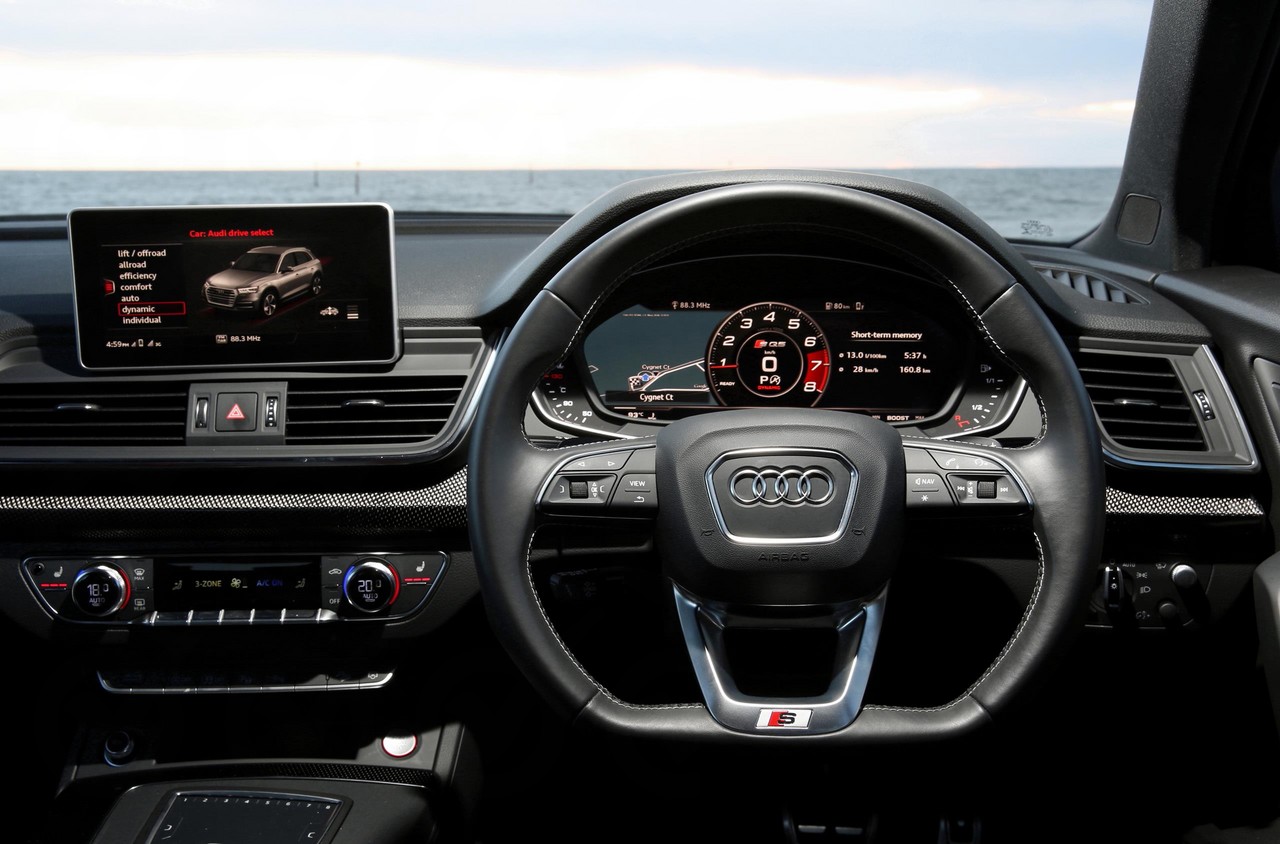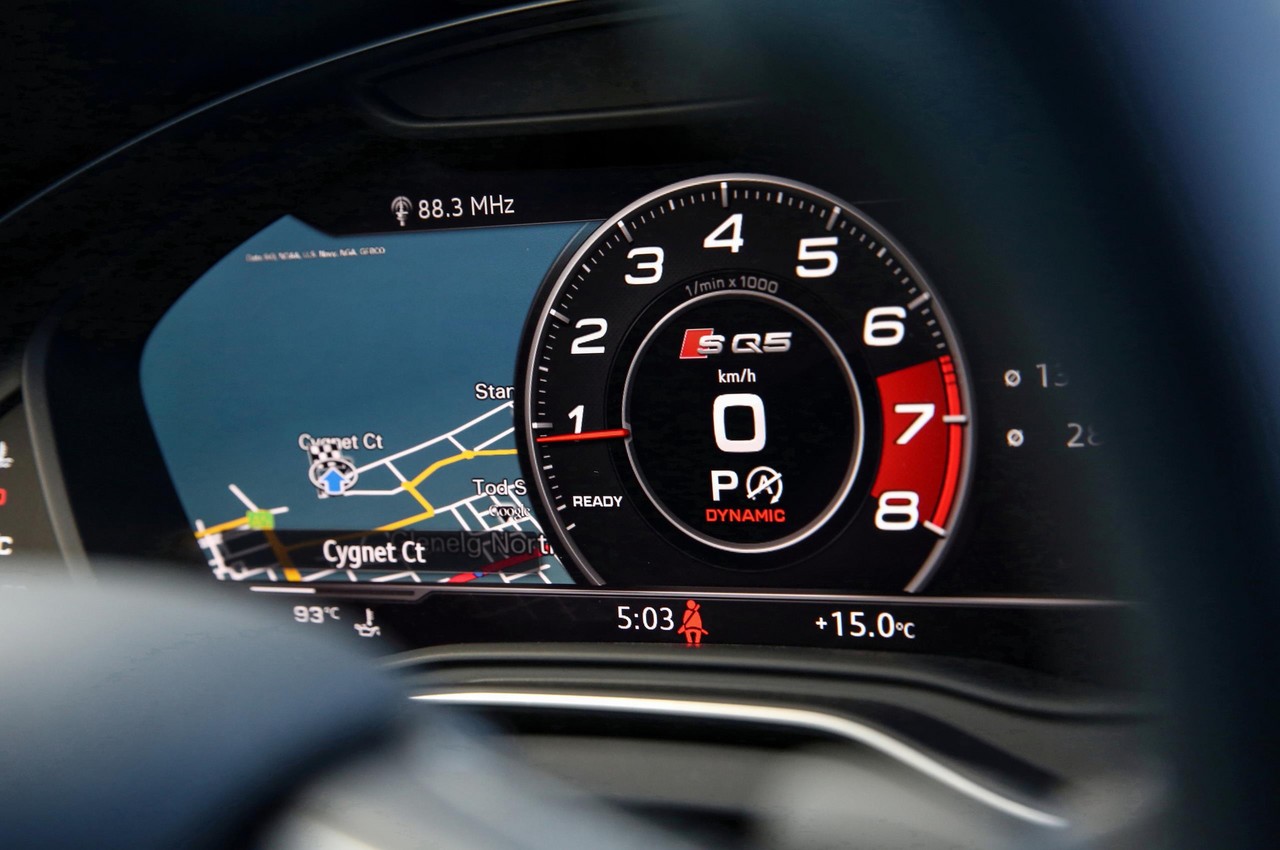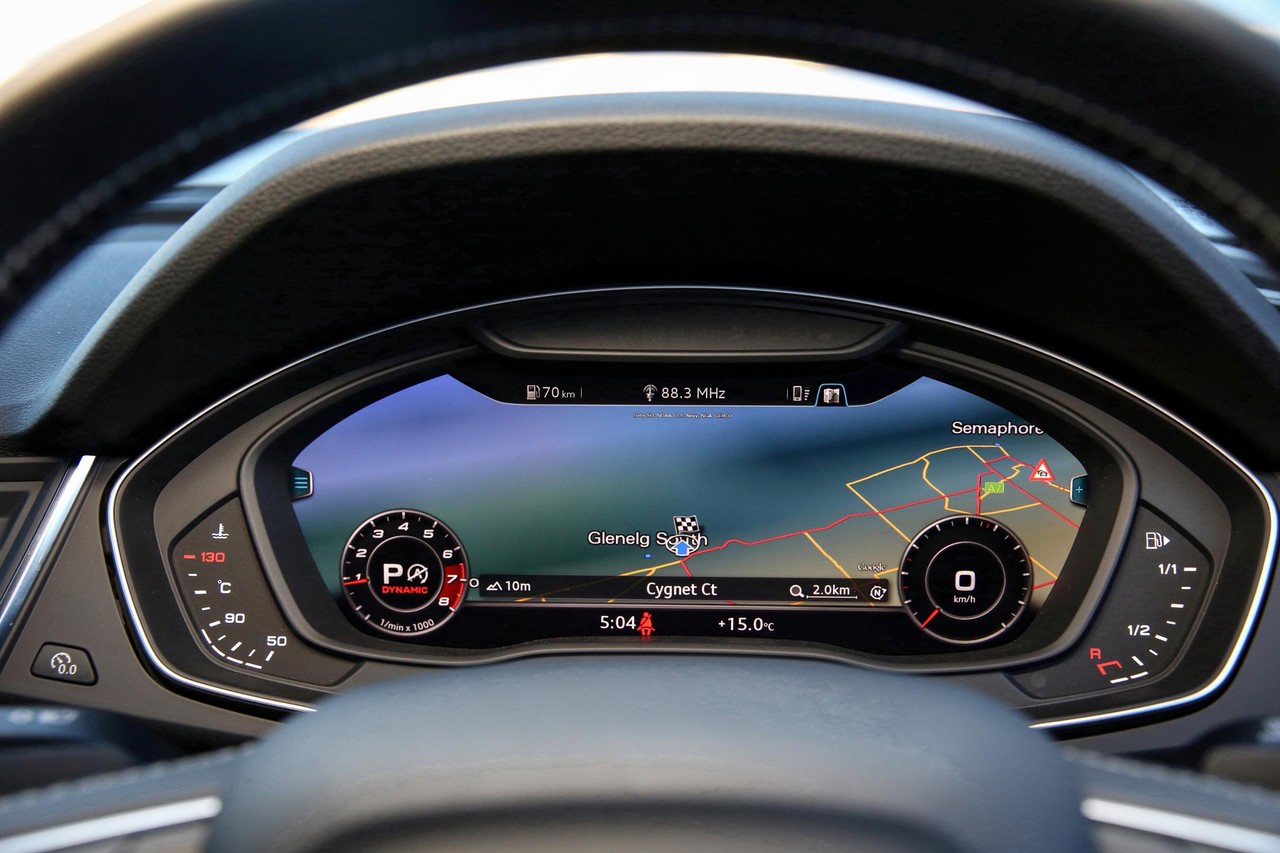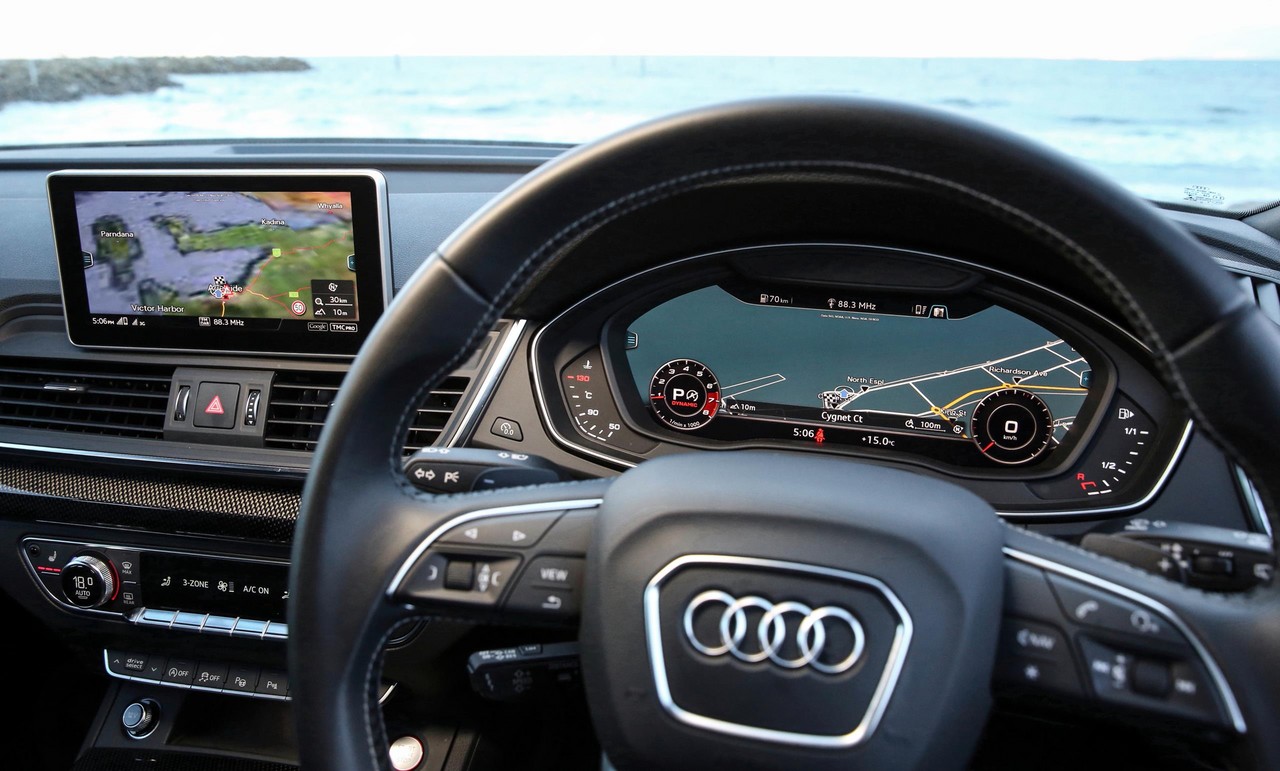
- Five star safety rating and active safety technologies
- Adaptive damping provides impressive ride/handling balance
- Refined eight-speed automatic transmission provides quick gear changes
- Quiet, well-insulated interior
- 3.0 TFSI is responsive and flexible…
- … but not as powerful as Mercedes-AMG GLC 43 or Porsche Macan Turbo
- Handling lacks agility of Porsche Macan and Jaguar F-Pace
- ‘Engine sound modulation’ from the sound system is contrived and pointless
- Steering lacks feel and is heavy in ‘Dynamic’ mode
- Quad-exhaust outlets are a styling exercise only
Overview
Released in Australia in July 2017, the Audi FY SQ5 was a mid-size SUV. Manufactured in San Jose Chiapa, Mexico, the all-wheel drive Audi FY SQ5 was powered by a 3.0-litre turbocharged V6 petrol engine that was mated to an eight-speed automatic transmission (Audi’s ‘Tiptronic’). Upon its release, the Audi SQ5 had a recommended retail price of $99,611 (excluding on-road costs).
CWGD 3.0 TFSI engine
The Audi FY SQ5’s CWGD V6 engine had 84.5 mm bores and an 89.0 mm stroke for a capacity of 2995 cc. Key features of the CWGD engine included its aluminium alloy crankcase and cylinder head, thin-walled grey cast iron cylinder liners, aluminium pistons, four valves per cylinder, variable intake and exhaust valve timing, variable exhaust valve timing, a twin-scroll turbocharger positioned between the 90-degree ‘V’ of the cylinder banks, direct injection and compression ratio of 11.2:1. To reduce fuel consumption, the CWGD engine had:
- A Start-Stop system which enabled it to shut down as the vehicle was coming to rest; and,
- A free-wheel function which disengaged the engine from the driveline to reduce engine braking at speeds between 55 km/h and 160 km/h.
To avoid knock (i.e. uncontrolled detonation), the CWGD had a shorter compression phase relative to the expansion phase. According to Audi, the variable valvelift system enabled short intake valve opening times of 130 crankshaft degrees under part loads by closing the intake valves early. At higher loads, the inlet valves were actuated via a camshaft contour that provided a longer opening time and larger valve stroke that to maximise engine power. The CWGD engine weighed 172 kilograms.
To reduce fuel consumption,
- The CWGD engine had a Start-Stop function which enabled it to shut down as the vehicle was coming to rest; and,
- A free-wheel function disengaged the engine from the driveline to reduce engine braking at speeds between 55 km/h and 160 km/h.
The Audi FY SQ5 could accelerate from rest to 100 km/h in 5.4 seconds, while its top speed was electronically limited to 250 km/h. Over the combined ADR 81/02 test cycle, fuel consumption for the Audi SQ5 was 8.7 litres per 100 km.
| Engine | Trans. | Peak power | Peak torque |
|---|---|---|---|
| 2995 cc CWGD turbo petrol V6 | 8sp auto | 260 kW at 5400-6400 rpm | 500 Nm at 1370-4500 rpm |
quattro all-wheel drive system
The ‘quattro’ system for the Audi FY SQ5 utilised a mechanical, self-locking differential. In normal driving conditions, the system provided a 40:60 front:rear torque split. According to Audi, however, up to 85 per cent of the engine’s torque could be directed to either axle if wheel slip occurred. As an extra-cost option, the Audi FY SQ5 could be specified with a ‘sport differential’ which actively distributed torque between the rear wheels via two superposition stages.
Body and dimensions
Like the Audi FY Q5 , the Audi FY SQ5 was underpinned by Volkswagen Group’s ‘MLB Evo’ platform. Compared to the Audi 8R SQ5 which it replaced, the FY SQ5 was 27 mm longer (at 4671 mm), 18 mm narrower (1893 mm), 11 mm taller (1635 mm) and had an 11 mm longer wheelbase (2824 mm). Inside, the SQ5 had a luggage capacity of 550 litres with the rear seats in position, though this increased to 1550 litres when the rear seats were folded down and luggage was filled to the roofline.
The Audi FY SQ5 had a kerb weight of 1870 kg (excluding the driver) and a drag co-efficient of 0.34 Cd.
Suspension
The Audi FY SQ5 had five-link front suspension with an aluminium transverse link and five-link rear suspension. Both the front and rear suspension were mounted on sub-frames, had track rods and tubular anti-roll bars. For Australia, the Audi SQ5 was fitted with electronically-controlled dampers (Audi’s ‘adaptive damper control’) as standard; the driver could also select from different drive settings using ‘Audi drive select’.
Steering
The Audi FY SQ5 had rack-and-pinion steering with electric, speed-sensitive power assistance. The steering had a ratio of 15.8:1, while the Audi SQ5’s turning circle was 11.7 metres.
Safety equipment
Standard safety equipment for the Audi FY SQ5 included dual front airbags, seat-mounted side airbags (front and rear), full-length curtain airbags, ABS, electronic brake force distribution, brake assist, electronic stability control, traction control and front seatbelts with pre-tensioners and load limiters.
The Audi FY SQ5 was also equipped with the following active safety technologies as standard –
- Audi pre sense city: operating at speeds up to 85 km/h, Audi pre sense city used a windscreen-mounted front camera to scan the road for other vehicles and pedestrians. If there was a collision risk, the driver would receive a series of warnings. If the driver failed to respond, full braking force could be applied autonomously. From initial speeds of up to 40 km/h, collisions could be prevented; at higher speeds (up to 85 km/h), the severity of the collision was reduced;
- Audi pre-sense front: could prevent front-to-rear collisions or reduce their severity. In hazardous situations, the driver received visual and acoustic warnings to apply the brakes, followed by a brief application of the brakes for a jolting effect to alert the driver;
- Adaptive Cruise Control (ACC): using two front radar sensors and the camera, ACC could maintain a specified distance – from five selectable distances – between the SQ5 and the vehicle ahead at speeds up to 250 km/h. Furthermore, ‘Audi drive select’ could be used to adjust the rate of acceleration and other control dynamics;
- Stop&Go function: an extension of the ACC and limited to models with automatic or double clutch transmissions, ‘Stop&Go’ operated at speeds of up to 60 km/h and could apply the brakes to bring the vehicle to rest. Once traffic began moving, the Audi SQ5 would automatically accelerate;
- Traffic-jam assist: an extension of the ACC, the traffic-jam assist function could take control of steering operations at speeds up to 65 km/h on ‘well-developed roads when traffic is congested.’ To do so, traffic-jam assist used lane markings and other vehicles on the road for orientation. When the traffic-jam assist function reached its limits – for example, when traffic was sparse or there was a sharp corner ahead – the driver had to take over steering. Hence, the system provided warnings at different levels;
- Audi pre sense basic: initiated occupant protection measures such as tightening the front seatbelts, closing the windows and activating the hazard lights when ‘unstable driving conditions’ were detected or a collision was anticipated;
- Audi pre sense rear: could warn of potential collisions from behind, alert following traffic by rapidly flashing the brake lights and activate the ‘Audi pre sense basic’ protection measures described above;
- Audi side assist: operating at speeds above 15 km/h, Audi side assist used two rear radar sensors to monitor traffic up to 70 metres behind the SQ5. If another vehicle was approaching quickly or was in the driver’s blind spot, a warning LED in the housing of the appropriate door mirror would illuminate. If the driver activated the indicator to change lanes, the LED would blink rapidly to warn the driver;
- Rear cross-traffic assist: when reversing at low speeds, rear cross-traffic assist used the rear radar sensors to detect approaching traffic. If approaching traffic was detected which may cross the vehicle’s path, the driver would receive warnings (visual and acoustic) and be alerted by a brief, jolting application of the brakes;
- Turn assist: active at speeds from 2 km/h to 10 km/h, ‘Turning assist’ could monitor oncoming traffic during right turns (for cars with right-hand drive). In hazardous situations, the brakes could be applied automatically to bring the vehicle to rest;
- Turning assist commenced operation when the driver activated the right-hand turn signal;
- Exit warning: activated when the vehicle stopped moving, exit warning would alert occupants if vehicles were approaching from behind by illuminating red fibre optics in the door-opening mechanism as the doors were opened;
- Multi-collision brake: in the event of a collision, the multi-collision brake function provided ‘controlled application of the brakes’ to prevent the car from skidding and to reduce the risk and severity of secondary collisions; and,
- Attention assist: monitored driver behaviour and issued a warning if the driver was assessed to be ‘inattentive’.
The Audi FY SQ5 also had an ‘active bonnet’ which deployed pyrotechnic charges in the event of a pedestrian collision to raise the height of the bonnet and locks to secure it to provide clearance over ‘hard points’ in the engine bay. In doing so, the likely severity of the pedestrian’s impact was reduced.
Euro NCAP testing
In Euro NCAP testing , the 2017 Audi FY Q5 received a five star safety rating which included a 93 per cent adult occupant protection rating and an 86 per cent child occupant protection rating. In the frontal offset test, occupant protection was generally rated as good though chest protection for the driver was rated as adequate (i.e. a slight risk of serious injury). While maximum points were awarded in the side impact, chest protection in the more severe pole test was rated as marginal.
Wheels, tyres and brakes
The Audi FY SQ5 had 8.0-J x 21-inch alloy wheels with 255/40 R21 102Y tyres. Furthermore, the Audi SQ5 had 350 mm by 34 mm ventilated front brake discs and 330 mm by 22 mm ventilated rear brake discs.
Features: Audi FY SQ5 3.0 TFSI
The infotainment system for the Audi FY SQ5 consisted of Audi’s ‘MMI navigation plus with MMI touch’ which included an 8.3-inch high resolution colour display and a touch control panel, integrated voice control and SUNA live traffic updates, Bluetooth mobile phone connectivity and audio streaming, Audi smartphone interface for Apple or Android integration via USB, and the ‘Audi connect’ in-car Wi-Fi hotspot. The Audi SQ5 also had a 180 watt sound system with 10 speakers (including sub-woofer) and a six-channel amplifier, a digital radio tuner (DAB+), CD/DVD player, Audi music interface with two USB inputs and a 3.5 mm auxiliary input socket, two SDXC card readers and a 10 GB flash memory for media storage.
Beyond this, standard features for the Audi SQ5 included power adjustable and heated front sports seats, Fine Nappa leather upholstery with diamond-patterned contrasting stitching, three-zone climate control air conditioning, LED headlights, LED daytime running lights, dusk-sensing headlights, rain-sensing wipers, 40:20:40 split rear seats with fore-aft sliding and reclining functions, a flat-bottomed leather steering wheel with gearshift paddles, remote central locking with proximity key, power adjustable and heated door mirrors with kerb-side view function for the passenger’s side, auto-dimming door and interior mirrors, power windows, a height and reach adjustable steering column, driver memory settings (for the driver’s seat and door mirrors), push-button start, matt brushed aluminium interior inlays, map lights, ambient interior lighting, floor mats (front and rear), rear privacy glass, tyre pressure loss indicator, a trip computer, an alarm and immobiliser. The Audi SQ5 was also equipped with:
- Audi’s ‘virtual cockpit’ which consisted of a configurable 12.3-inch high resolution colour display rather than conventional analogue instruments;
- A 360 degree camera system which used four wide-angle cameras;
- High beam assist: automatically switched between low and high beam headlights to improve visibility and avoid dazzling other drivers, using a sensor to determine when it was safe to do so;
- ‘Audi parking system plus’: front and rear parking sensors, a rear view camera and visual display; and,
- A power-operated tailgate which could be opened or closed by a kicking motion beneath the rear bumper.
2019 Audi SQ5 Black Edition
The Audi SQ5 Black Edition was released in Australia in April 2019. Visually, the SQ5 Black Editoin could be identified by its 21-inch alloy wheels, high-gloss ‘titanium black’ exterior package (including black door mirrors and roof rails) and metallic paint finishes. Standard features for the Audi SQ5 Black Edition were extended to include a Bang & Olufsen 3D sound system, head-up display and extended upholstery package.
September 2019 update
From September 2019, the Audi SQ5 was equipped with a Bang & Olufsen 3D sound system, extended upholstery package, variable front-seat head restraints with fore-aft adjustment, a panoramic glass sunroof and head-up display. Furthermore, metallic paint finishes were available at no additional cost.
Specifications and technical data
- Specifications: Audi FY SQ5 (June 2017)
- Specifications: Audi FY SQ5 (September 2019)
- Technical Data: Audi FY SQ5 (June 2017)
